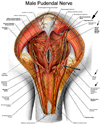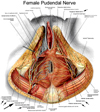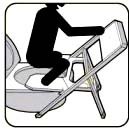|
Pudendal Nerve - Mission Control Center for Pelvic OrgansThe pudendal nerve is responsible for proper functioning and control of urination, defecation and orgasm in both males and females. Located deep within the pelvic region, the pudendal nerve emerges from the base of the spinal cord (sacral area), and separates into three branches. One branch goes to the anal-rectal area. The second branch goes to the perineum - the sensitive area between the anus and penis or vagina. The third branch goes to the penis or clitoris itself.
Because the it carries signals between the brain and the pelvic organs (bladder, genitals, prostate, colon), serious problems can occur in the event of an injury. These include: 1) Urinary incontinence The last two are chronic conditions which can cause great pain in lower pelvic areas (scrotum and penis, vagina, perineum, anal region). In short, life loses most of its joys and pleasures when this 'mission control' pelvic nerve is injured. There are many ways that this can happen - cycling, pregnancy, accidents and scarring due to surgery. However, what is less known is underlying cause: the long-term use of sitting toilets for defecation. Research (eg: Tagart, 1966) had clearly shown that there is a significant difference in the shape of the rectum and anal canal in the sitting and squatting postures. In the sitting position, there is a sharp kink between the rectum and the anal canal. In the squatting position, however, the pathway is straightened.
(Click here to see the difference.)
SIDENOTE The pudendal nerve, which weaves its way through the pelvic floor muscles, is not designed to cope with the repeated downward movements of the pelvic floor. It can suffer from what is known as nerve stretch injury, when it is stretched by as little as 12%. For those who use the seated posture for defecation, damage and injury almost seem certain... if not in a few years, then in ten to twenty years down the road. The use of traditional Asian, African, Middle Eastern or Indian toilets – which require users to squat for bodily functions – is the best - and most sensible - way to prevent this from happening.
|
The Best Toilet Converter in The World Today!


Helping People All Over
The World Achieve
Good Health Through
Correct Toileting Posture
Watch video on the
origin and story of
the Sandun-Evaco
toilet converter
All about Life,
Hope and Truth...
FREE:
One of the most
astounding books
you will ever read
in your life!










